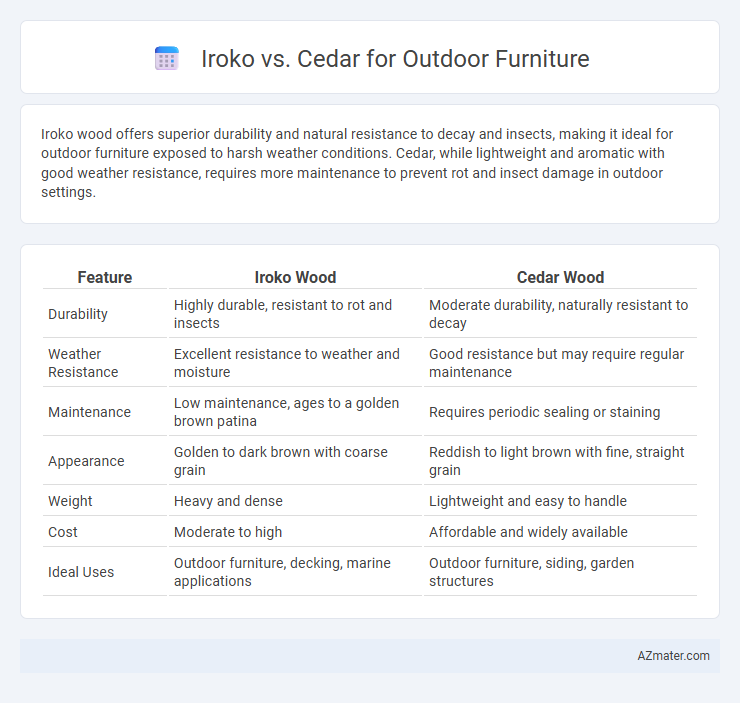Iroko wood offers superior durability and natural resistance to decay and insects, making it ideal for outdoor furniture exposed to harsh weather conditions. Cedar, while lightweight and aromatic with good weather resistance, requires more maintenance to prevent rot and insect damage in outdoor settings.
Table of Comparison
| Feature | Iroko Wood | Cedar Wood |
|---|---|---|
| Durability | Highly durable, resistant to rot and insects | Moderate durability, naturally resistant to decay |
| Weather Resistance | Excellent resistance to weather and moisture | Good resistance but may require regular maintenance |
| Maintenance | Low maintenance, ages to a golden brown patina | Requires periodic sealing or staining |
| Appearance | Golden to dark brown with coarse grain | Reddish to light brown with fine, straight grain |
| Weight | Heavy and dense | Lightweight and easy to handle |
| Cost | Moderate to high | Affordable and widely available |
| Ideal Uses | Outdoor furniture, decking, marine applications | Outdoor furniture, siding, garden structures |
Introduction to Iroko and Cedar Wood
Iroko wood, also known as African teak, is a durable hardwood prized for its resistance to rot, insects, and weather, making it ideal for outdoor furniture. Cedar wood, specifically Western Red Cedar, is lightweight and naturally resistant to moisture, decay, and insect damage, offering a pleasant aroma and attractive reddish hue. Both woods provide excellent longevity and aesthetic appeal, with Iroko delivering greater hardness and Cedar offering superior natural oils for protection.
Durability Comparison: Iroko vs Cedar
Iroko wood offers superior durability for outdoor furniture due to its high oil content and dense grain, making it highly resistant to rot, insects, and weathering compared to Cedar. Cedar, while naturally resistant to decay and insects, is softer and more prone to dents and surface wear over time, requiring more maintenance to retain its appearance and strength. For long-lasting outdoor furniture exposed to harsh elements, Iroko provides a more robust and low-maintenance option than Cedar.
Weather Resistance and Outdoor Performance
Iroko wood exhibits excellent weather resistance due to its dense grain and natural oils, making it highly durable against moisture, rot, and insect damage in outdoor furniture. Cedar is also prized for its natural resistance to decay and insects, with a lighter weight and better dimensional stability that reduces warping in fluctuating climates. Both woods perform well outdoors, but Iroko's superior hardness and oil content provide enhanced longevity in harsh weather conditions compared to cedar.
Appearance and Aesthetic Differences
Iroko wood features a warm golden to dark brown hue with a coarse, interlocking grain that adds a distinctive, rustic charm to outdoor furniture. Cedar exhibits a lighter reddish tone with a fine, straight grain, providing a smooth and elegant appearance that naturally resists weathering. The rich, contrasting textures of Iroko emphasize a bold, durable aesthetic, while cedar's subtle, consistent coloration offers a more refined and classic outdoor look.
Maintenance Requirements for Each Wood
Iroko wood requires minimal maintenance due to its natural oils that enhance resistance to rot and insect damage, making it ideal for outdoor furniture with only occasional cleaning and oiling needed to maintain its appearance. Cedar wood demands more frequent upkeep, including regular sealing or staining to protect it from moisture and prevent weathering or discoloration over time. Both woods benefit from periodic inspections and cleaning, but Iroko's durability significantly reduces the overall maintenance effort compared to cedar.
Sustainability and Environmental Impact
Iroko wood, sourced from fast-growing trees in West Africa, offers a sustainable choice for outdoor furniture due to its rapid regeneration and minimal deforestation impact compared to cedar, which is often harvested from slower-growing, older forests. Both woods are naturally resistant to decay and insects, reducing the need for chemical treatments, yet iroko's durability rivals that of teak, making it a longer-lasting option that lowers replacement frequency. Cedar's lower density means less energy consumption in transport and processing, but iroko's sustainability benefits are enhanced by certifications from organizations like FSC, ensuring responsible forest management.
Cost Analysis: Iroko vs Cedar
Iroko wood generally costs more than cedar due to its durability and resistance to rot, making it a long-term investment for outdoor furniture. Cedar is more affordable upfront but may require more frequent maintenance and replacement over time, increasing total expenses. Comparing price per board foot, Iroko ranges from $10 to $15, while cedar averages $5 to $8, highlighting the cost trade-off between initial outlay and longevity.
Workability and Ease of Construction
Iroko wood offers excellent workability due to its moderate density and natural oils, making it resistant to splitting and easy to machine, which simplifies cutting, sanding, and fastening for outdoor furniture construction. Cedar, known for its lightweight and soft texture, provides superior ease of construction with high machinability and resistance to warping, though it requires careful handling to avoid dents and scratches. Both woods perform well in outdoor environments, but Iroko's durability complements its workability for robust furniture, while cedar's lightness enhances manageable assembly and finishing.
Longevity and Lifespan in Outdoor Settings
Iroko wood offers exceptional durability with a natural resistance to decay, insects, and weather, often lasting 25 to 30 years in outdoor furniture applications without significant deterioration. Cedar is valued for its natural oils that repel insects and resist moisture, providing a lifespan of around 15 to 20 years when properly maintained in outdoor settings. Both woods require maintenance to maximize longevity, but Iroko's dense grain and hardness generally extend its outdoor lifespan beyond that of cedar.
Which is Better for Outdoor Furniture: Iroko or Cedar?
Iroko wood offers superior durability and natural resistance to rot and insects, making it highly suitable for outdoor furniture in harsh weather conditions. Cedar, valued for its aromatic oils and lightweight nature, provides moderate decay resistance and a warm aesthetic, but requires more maintenance over time. For long-lasting, low-maintenance outdoor furniture, iroko's toughness and weather-resistant properties generally make it a better choice than cedar.

Infographic: Iroko vs Cedar for Outdoor Furniture
 azmater.com
azmater.com